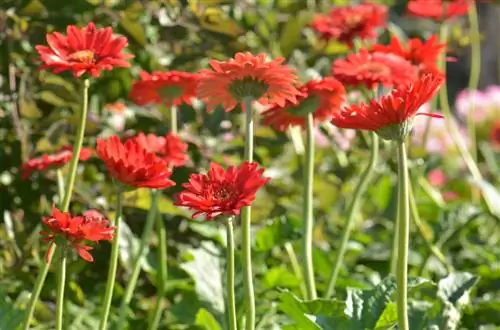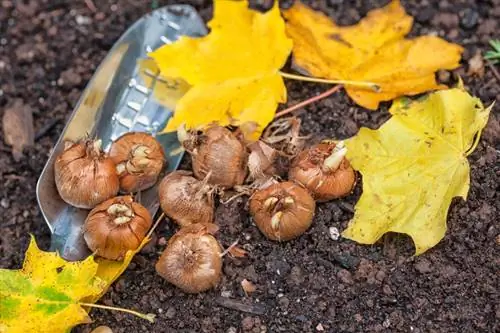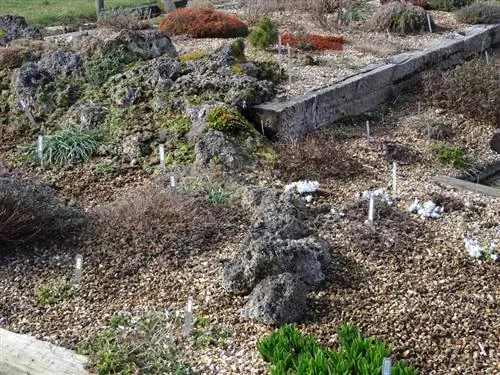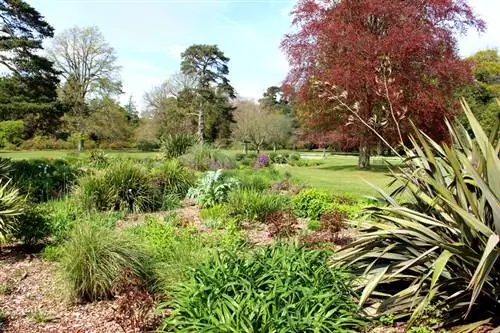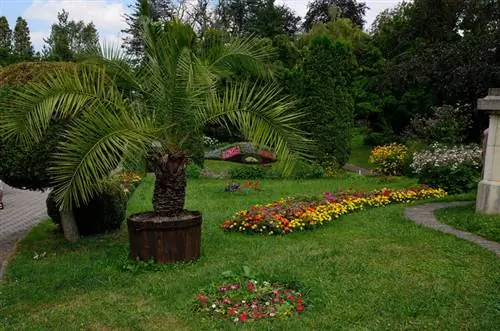- Author admin [email protected].
- Public 2023-12-16 16:46.
- Last modified 2025-06-01 06:02.
Read a commented honey palm profile here with explanations of growth and winter hardiness. You can find out how much you can buy Jubaea chilensis here. Tips about planting and care worth reading.
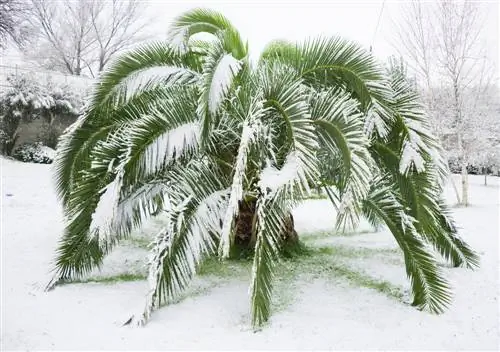
What are the characteristics of honey palm?
The honey palm (Jubaea chilensis) is a slow-growing, partially hardy feathered palm from Chile. It thrives best in full sun to sunny locations and can tolerate temperatures down to -15°C with winter protection. The palm tree can grow up to 30 m tall and bears pinnate leaves, purple flowers and edible drupes.
Profile
- Scientific name: Jubaea chilensis
- Family: Palm family (Arecaceae)
- Origin: Chile
- Synonyms: Chilean honey palm
- Growth type: Feather palm
- Growth habit: single-stemmed, umbrella-shaped
- Growth height: 3 m to 30 m
- Leaf: pinnate
- Flower: panicle
- Fruit: Drupe
- Winter hardiness: conditionally hardy
- Use: pot, garden palm
Growth
The honey palm is a pinnate-leaved palm tree native to Chile. Jubaea chilensis is the only one of its kind that does not tolerate any other conspecifics within the honey palm genus (Jubaea). In its home region, the feather palm thrives at the foot of the Andes, where a Mediterranean-like climate prevails. The German plant name is a reference to the sugary sap in the trunk, which is used as a basic ingredient for palm honey, palm sugar and palm wine. In several respects, the honey palm is one of the record holders with superlatives, such as the hardiest palm tree and the thickest palm trunk. Read these key growth data worth knowing:
- Growth habit: single-stemmed palm with a characteristic crown of evergreen, feathery fronds, long inflorescences and edible drupes.
- Growth height in the habitat: 15 m to 30 m.
- Growth height in the pot: 3 m to 7 m.
- Trunk: forms from 15 to 25 years old, gray bark with characteristic leaf scars, up to 150 cm in diameter, slightly tapered in the crown area.
- Roots: Taproots
- Growth speed: in the pot 5 cm to 8 cm, planted out 10 cm to 15 cm growth per year.
- Gardeningly interesting properties: easy to care for, moderately hardy, non-toxic, pruning not necessary, decorative potted plant all year round, planting out is possible.
Video: Chilean honey palm in a short portrait
Winter hardiness
In its homeland, the honey palm thrives at the foot of the Chilean Andes. The climate there is similar to the Mediterranean region with dry summers and cool-tempered to slightly frosty winters. Unlike tropical palm species, the Chilean honey palm has learned to survive in temperatures below freezing. The degree of frost tolerance depends on the planting:
| Honey palm winter hardiness | Planted out | potted plant |
|---|---|---|
| with winter protection | up to - 15° Celsius | up to - 8° Celsius |
| without winter protection short term | up to - 10° Celsius | up to - 5° Celsius |
| permanent without winter protection | up to - 5° Celsius | 0° Celsius |
You can read about the specific measures behind the term winter protection in the care instructions on the topic of wintering.
Leaf
Long time before the trunk forms and the first flowering period, the honey palm thrives with impressive fronds that, at first glance, are reminiscent of a date palm. Read a brief overview of all the important leaf features here:
- Leaf shape: petiolate, pinnate with numerous individual leaves in two rows.
- Leaf size: up to 5 m long and wide
- Single plumage: narrow-lanceolate, pointed, 30 cm to 50 cm long.
- Leaf color: dark green
Bloom
A honey palm tree takes 50 years or longer to bloom for the first time. The wait is worth it given these flower features:
- Inflorescence: 50 cm to 150 cm long panicle with numerous individual flowers.
- Single flower: tripartite (3 sepals and 3 petals).
- Flower color: crimson red with a creamy white base.
Jubaea chilensis is one of the monoecious, separate-sex feather palms. Single male and female flowers gather on separate inflorescences of a honey palm.
Fruit
Fertilized, female inflorescences of a honey palm bear a sweet load of fruit with these characteristics:
- Fruit type: Drupe with white, fibrous pulp and a large seed.
- Fruit size: 3 cm to 4 cm in diameter.
- Fruit color: green, yellowish when fully ripe.
Honey palm seeds are also called coconuts (coquitos) because their appearance and taste are reminiscent of a small coconut.
Planting honey palm
You can buy a Chilean honey palm ready to plant at any time of the year. A suitable location is quickly found. Planting in the garden or in containers is easy. Read here how and where to plant a honey palm correctly:
Buy honey palm
Due to the very slow growth, the growth height primarily determines the purchase price of a honey palm. The following table provides an informative overview of the price structure as a non-representative snapshot:
| Growth height | Honey Palm Price |
|---|---|
| 30cm | from 25 euros |
| 40 cm | from 30 euros |
| 150cm | from 290 euros |
| 250cm | from 530 euros |
| 300cm | from 750 euros |
| 1200cm | from 30,000 euros |
Location
In the right location, the light and temperature conditions simulate similar conditions to those at the foot of the Chilean Andes or in the Mediterranean region:
- Full sun to sunny location.
- Warm, protected from rain and wind
- Honey palm in a pot, ideally from April to September/October on the south-facing balcony.
- Extra tip: 14 days of acclimatization in partial shade prevents sunburn after clearing out.
Substrate, soil
You can plant the honey palm in mild winter regions of winter hardiness zone Z8 as well as in the garden with a Mediterranean microclimate. Substrate quality and soil conditions are based on similar specifications. Important key data to read:
- Bucket substrate: coarse-grained, loose, permeable palm soil without peat with a few handfuls of lava granules.
- Bedding soil: sandy-loamy to gravelly garden soil, fresh to moderately dry, ideally neutral to slightly acidic.
Planting tips for beds and containers
The best time to plant the honey palm is in spring. This choice of date ensures that the partially hardy feather palm can take root well before the first frost. The following planting tips get to the heart of all the important aspects:
- A high special palm pot with an opening in the bottom as a water drain is suitable as a bucket.
- The diameter of the correct pot is two to three finger widths larger than the root ball.
- Planting in pots and beds requires a layer of expanded clay or gravel at least 10 cm high as drainage.
- You should only plant a Jubaea chilensis after a five to seven year growth phase in the pot.
- The planting depth in the bucket or bed corresponds precisely to the previous planting depth. Honey palms planted too deeply suffer from rot at the base and, in the worst case, die.
In the last step of professional planting, please water the honey palm thoroughly. Regular watering is mandatory in the following weeks. Drought stress is the most common cause when a Chilean palm tree fails to grow.
Excursus
Honey palm and hemp palm - hardy feather palm duo
Honey palm and hemp palm compete for the title of the hardiest palm north of the Alps. With winter protection, both feather palms can withstand bitter frost down to -15° Celsius. Creative hobby gardeners take advantage of this fact by planting the Chilean honey palm (Jubaea chilensis) and Chinese hemp palm (Trachycarpus fortunei) side by side in the garden.
Care for honey palm
A honey palm is easy to care for. The focus is on the correct winter protection for the partially hardy feather palm. Other relevant care topics include water and nutrient supply. The topics of pruning care, propagation and repotting should be familiar at least in basic terms. The best care tips for speed readers:
Wintering
- Winter indoors in a pot: ideally bright and frost-free at 5° to 10° Celsius; alternatively at normal room temperatures with additional lighting (€21.00 on Amazon).
- Winter outside in a bucket: ideally place under a winter tent; Alternatively, place the bucket on a polystyrene plate, cover it with coconut mats, put a breathable hood over the leaflets, mulch the substrate with bark mulch.
- Overwintering the planted honey palm: Tie up the palm fronds with coconut string, stuff the gaps with straw, wrap the trunk with winter fleece, mulch the root disc to a height of 20 cm to 30 cm.
- Winter care: water in dry conditions, do not fertilize.
Pouring
- Water the honey palm thoroughly when the soil is dry, without causing waterlogging.
- Let the pot substrate and bed soil dry to the touch until the next watering (1-2 cm deep finger test).
- Use predominantly rainwater or stale tap water as irrigation water.
Fertilize
- Fertilize Jubaea chilensis from April to September.
- Add liquid palm fertilizer to the irrigation water every three to four weeks.
- Provide the planted honey palm with leaf compost or liquid fertilizer.
Cutting
- Cut off dead, completely dry leaflets.
- When cutting, leave a short piece of the petiole.
- Important: Never cut the palm tip as the only point of vegetation.
Propagate
- Propagate honey palm by sowing.
- Soak seeds in decalcified water for 3 days.
- Remove shell with a nutcracker.
- Plant half of a seed in a seed pot with coconut soil.
- Germinate in the warm, humid microclimate of an indoor greenhouse at 18° to 22° Celsius.
Repotting
- Repot slow-growing honey palm every two to three years.
- The best time is in spring.
Popular varieties
No honey palm varieties are known beyond the original species Jubaea chilensis.
FAQ
Is the Chilean honey palm hardy?
The Chilean honey palm thrives in this country as a partially hardy feather palm. When planted out and with winter protection, a Jubaea chilensis can tolerate bitter cold down to -15° Celsius. Planting in a bucket reduces frost tolerance with winter protection to -5° Celsius.
How fast does the Chilean honey palm grow?
The honey palm is one of the slowest growing feather palms. In the pot, the Chilean honey palm grows between 5 cm and 8 cm per year. When planted out in the garden, the growth rate accelerates to at least 10 cm to 15 cm growth per year.
How much can you buy a honey palm?
Beautiful honey palms are available for every budget. The purchase price primarily depends on the height. You can get a young Jubaea chilensis with a height of 30 cm from 25 euros. A man-high Chilean palm tree costs around 300 euros. You'll have to dig deep into your pockets for a majestic honey palm with a height of 12 meters and a massive trunk. Such a gem is at least 50 years old and costs around 30,000 euros.
What to do about white dots on the fronds of a honey palm?
White spots on the leaves of a honey palm are a symptom of pest infestation. As a rule, these are spider mites or lice, especially scale insects and mealybugs. As an immediate measure, simply take a damp cloth and wipe off the white dots. Then combat the pests with a proven home remedy. Make a solution from 1 liter of water, 30 milliliters of soft soap and 1 tablespoon of spirit. Pour the liquid into a hand sprayer and spray the tops and bottoms of the fronds several times a week until white spots no longer appear.


